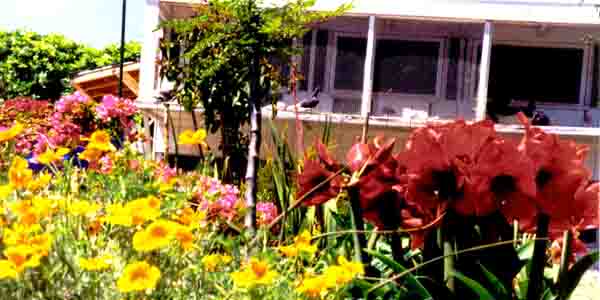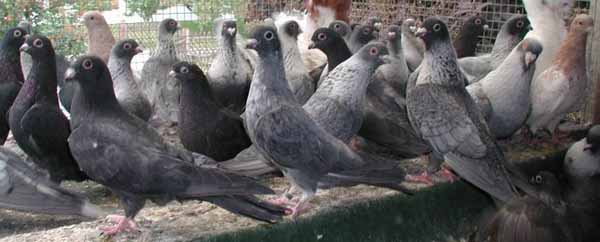I decided to take a longer break by taking snaps for the surrounding, which had led me to rather finish the whole roll than going back to the coop. My friends either you take their pictures at dusk with a good flash or wait until they lay eggs and capture them motionless.
If you enjoy gardening you may go to My Garden link for more viewing, otherwise please continue on with the letter .

The cluster of yellow flowers are California Puppies, which is our state flower. On the right of that is another cluster of Amaryllis. The Amaryllis flower is bright red with velvety texture.
Behind the Puppies and blooming in dark pink is a string of Boganvilla flowers. Pigeon dropping is recycled and worked up for better soil condition. On the loft's board few youngsters taking a bath and sunning after flying. Spring also has brought up a pair of Coopers that are nesting near by. I spot them every day swooping after the abundance of Doves feeding on the wild seeds of Rye around the sprawling Canyons. They get very aggressive against Ravens that try to approach their nesting area and that's how I guessed that they are nesting around here. They seldom attack my pigeons even I have several young on the loose most of the day. The Peregrine falcons are also nesting nearby. To my judgment it appears to be the same pair. The male is much smaller and really moves fast. Both are extremely aggressive and have followed the Pigeons from heights down to trees surrounding the loft. The Swifts have fared so well without any loss so far. It is fare to say that a good flying Swift can maneuver his way out from the Falcon most of the time. As for the sneaky Cooper, the only way is not to have the pigeons confronting him during the migration season.
E-mail: I have selected five consecutive e-mail that were
exchanged between me and Nico veen from Netherlands to make the following
discussion that I need to know your take on it.
Nico has visited Syria and spent time to see the Syrian-Lebanese birds.
He based his e-mail's with me on his confusion of what he sees and hear
in Europe versus Pigeons he witnessed during his visit.
The display on this site created even more discussion between him and
other Fanciers to the validity of the birds in Europe as ES. He wonders
if the Egyptian Swifts should have longer wings than tail and shouldn't
they be all very long? Therefore are poor flying birds. He also indicated
that" facial recognition and grouping are not recognized in Europe"

Answer: The highlight of my e-mail response was based on
pictures on this site and the picture included above
of the so called Syrian Swifts. If you have been following this letter,
you might have noted that I talk about the beak setting and facial recognition
in just about every letter to assert it's importance above other characteristics
unique to the Swifts. The crispness of color, pattern, style are easier
to recognize.
Cover the heads of the entire bird population with your hand (ignoring
the brown birds) and observe their color, could you then classify them
as Otatis based only on color ? Of course not.
You don't have the body style in any of them to include under ES. Well,
you say let me then see the full head to get more clues. Great, Now stay
with me. I will reverse the process by covering the body and let you only
look at the heads. Now tell us honestly what are you looking at? I see
now you muddling and wringing your hands. Why? By looking at them one
could not detect a distinctive facial markings among these birds to place
them in a class. Simply there is no unison among the birds heads. You
have looked around and at the far right corner you saw a Rehani's head
and you know that it is carried of an Otati's color.
Where is the powerful head and the broad and short mandibles? another
words they don't have the Otatis features.
What are they then? Syrian Swifts! Is it because they are shorter birds?.
And how about that long black bird with a long face on the left of the
picture?
Now we both agree that neither color nor the length of the bird will qualify
it to belong to certain breed. I will use the American Show Racer (ASR)
and the Oriental Frills to qualify my point just in case you aren't familiar
with ES versus SS. Both have the Andalusian markings known to you. They
are classified as is based on facial markings and not because of their
color.
It goes that way for animals, birds and others. They are classified primarily
on their looks and secondary on other features.
It has taken years and years to get the ES developed to this level. We
should refine them as close as possible to their standards. Do you know
of anyone who has come up with anything better than a standard bird or
produced a color that does not exist currently in ES by mixing?
I was told by several that the random introduction started initially because
of lack of birds.
" The Pigeons" by Levi has a picture of an Otati that was attributed
to Sam Shadeed. Sam who was a Syrian immigrant to the USA in the late
Fifties introduced the Syrian-Lebanese birds in this country and among
them Otatis and possibly Rehanis. Long birds with week flying ability
were dubbed ES and the short and stronger flying were referred to as SS.
This new classification has spread throughout Europe and the west and
indeed it is much easier concept to explain for those with no knowledge
of a true Swift.
The market had soon absorbed the extra birds at cheap prices until the
euphemism "Syrian Swifts" was fully accepted.
As soon as the buyer realizes what he is in, he turns around and pass
it on to another. Fanciers in the USA have become clearly aware of these
facts as I have noted from their writing in our local US magazines and
that has helped to improve the number of good ES birds in the USA.
The fact that you can't buy a breed from were it was claimed to have originated
sums it up all.
"It's all made up outside Syria"and neither the Syrian nor the
Lebanese had anything to do with it.
If you doubt me, then present me with importation documents via Syria
to USA or Europe indicating it's validity..
DR Christian Otraji who is originally from that part of the world will
tell you that there is nothing called Syrian Swifts in Syria, but either
ES or poor quality ES. The European notion will keep on propagating as
long as the Europeans have little or no exposure to true ES.
Saied Mada in Austria, who is originally from Egypt, has imported a number
of good birds and intends on getting these points cleared in Europe using
the German language in his writing. You may visit his new site "Sphinx
Loft" to see his work and for now it's done in English.
Another site comes from Canada " Cleopatra
Loft" and run by Michael Phares. Michael who has grown
up also raising ES in Egypt is breeding them exclusivelyonly in Canada.
Mike has excellent commands of English, French and of course Arabic. There
are other great lofts that I know of here in the USA and I encourage all
ES fanciers to link and give brief description at their convenience.
A Popular Mix
What would you get from Otati, Rehani and Blue Velvet mixture ? They all
extreme and will likely produce Blue Velvet-like bird or an Opal rusty
color. The powerful head of an Otati and the inclined beak becomes narrow
with a conspicuous forehead. The opposite happen to the finely structured
Rehani. It's marble size skull becomes enlarged and the beak gets long
and broad. The beautiful slender body of a Rehani with it's shining beetle
sheen color become inflated and its color reflect a dull sooty color or
even a tinge of faded bronze color.
Uncontrolled mating should not be allowed unchecked in any breed. Introduction
should be limited to one generation as close as possible to the original
group with a hope that one might come up with a bird that could blend
in well with the original. Experimenting is part of my job as a Clinical
Scientist, but it has to be planned well. Making the improbable a reality
could only happen by meticulous planning and great knowledge to all ES
groups.
Where do we go from here: We have
ancient standards to go by and it's all translated to you for you. It
is the duty of every one of us as Swifts fanciers to explain these facts
to others. As I have said before" I have no control of what goes
out of my loft". If you cross them with Homers or others, they are
your birds.
I express my deep thanks for allowing me to use this well rounded photo
as an educational tool for the rest of us. On my behalf, I will donate
a prime pair of Otatis for you as soon as you arrange for your shipping
and yes you should start over again.
E-mail: Should the color on the Otatis primaries display
an even and homogenous blue?
Answer: You have three primary colors or dilution's on the
Otatis. A dark bird (Mehalawi) , Medium Andalusian color and finally the
light opal or diluted version (Saboni). They all should have a Platinum
mane. The Sabonis probably lack the Sooty genes, therefore their males
show the recessive homozygous pale more clearly. It is a sex linked trait
and does not show with the same intensity on hens. By looking at the male's
wings, one could likely tell if it has descended from Sabonis. Mating
these birds together is acceptable.
Thank you for your pictures and e-mail as they are the only source for this letter. Will meet later. Your feed back on this topic is very much appreciated. I don't use names unless you submit an article or indicate otherwise. See next letter.